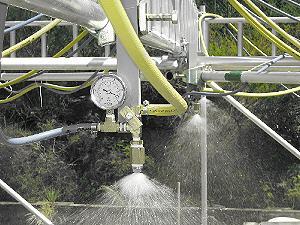Posted 13 March 2008

Simulator nozzle
In 2007, the Water Research Laboratory (WRL) commissioned a rainfall simulator for the investigation of surface runoff and infiltration processes under field conditions. South-East Australian rainfall patterns make it very difficult to conduct field investigative campaigns of runoff and infiltration under normal conditions without sustained programme durations. The rainfall generator has been built to enable more rapid field testing and based around a published design to achieve size distributions and at-surface droplet velocities that are as similar as possible to natural rainfall.
Specifications of simulated rainfall:
Whilst infiltration and runoff behaviour can be estimated by a range of hydrological techniques, the simulator has been designed to obtain real runoff and infiltration data not accessible using sprinklers or infiltrometers. The large test area gives it the potential to be linked to subsurface monitoring including multi-level piezometers and vadose zone moisture monitoring. An entire monitoring system would provide unique data regarding rainfall, runoff, soil moisture response and subsurface recharge. The rainfall simulator is transportable to multiple sites to determine spatial recharge functions across natural landscapes. This type of recharge measurement is critical to provide base-line data and independent verification of numerical groundwater flow models.
Potential applications include:
For further information please contact Dr Bill Peirson (w.peirson@unsw.edu.au) or Dr Wendy Timms (w.timms@wrl.unsw.edu.au) at WRL.
Links:

Professor Andy Baker features in American Water Resources Association ‘Water Resources Impact’, September 2020 edition.

The Connected Waters Initiative (CWI) is pleased to welcome Taylor Coyne to its network as a postgraduate researcher. If you’re engaged in research at a postgraduate level, and you’re interested in joining the CWI network, get in touch! The CWI network includes multidisciplinary researchers across the Schools of Engineering, Sciences, Humanities and Languages and Law.

The Grand Challenge on Rapid Urbanisation will establish Think Deep Australia, led by Dr Marilu Melo Zurita, to explore how we can use our urban underground spaces for community benefit.

On the 21 August 2020, CWI researchers made a submission to the National Water Reform Inquiry, identifying priority areas and making a number of recommendations as to how to achieve a sustainable groundwater future for Australia.

Results published from a research project between the Land Development Department (LDD) Thailand and UNSW has demonstrated how 2-dimensional mapping can be used to understand soil salinity adjacent to a earthen canal in north east Thailand (Khongnawang et al. 2020).